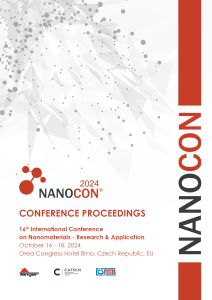Proceedings
Back

Conference Proceedings - NANOCON 2024
16th International Conference on Nanomaterials - Research & Application
October 16 - 18, 2024 / OREA Congress Hotel Brno, Czech Republic, EU
www.nanocon.eu
ISSN: 2694-930X
ISBN: 978-80-88365-24-2
Published: 2025
Read
more
Past events
Table of Contents
MIKULE Jaroslav Technical University of Liberec, Faculty of Science, Humanities and Education, Department of Chemistry, Liberec, Czech Republic, EU, jaroslav.mikule@tul.cz
Co-authors:
SIVAN Manikandan
MADHESWARAN Divyabharathi
CHUDOBOVÁ Ema
HAUZEROVÁ Šárka
CHVÁTIL David
OLŠANSKÝ Václav
BĚHÁLEK Luboš
KUŽELOVÁ KOŠŤÁKOVÁ Eva
LUKÁŠ David
DOI: https://doi.org/10.37904/nanocon.2024.5027, 259-265
Abstract:
Microplastics originating from the degradation of plastic waste are considered a global concern for the environment, with microplastic fibres from synthetic textiles being responsible for the majority of microplastic pollution. Over the past few decades, there has also been a notable increase in the production of synthetic polymeric materials in the form of nanofibers for various applications. [..]
Read more
SKOPALÍK Josef Faculty of Biomedical Engineering, Czech Technical University in Prague, Czech Republic, EU, skopajos@fbmi.cvut.cz
Co-authors:
PRŮCHA Jaroslav
PARÁK Tomáš
ČMIEL Vratislav
SEKORA Jiří
DOI: https://doi.org/10.37904/nanocon.2024.5028, 266-270
Abstract:
Several experimental strategies have been formulated to develop theranostic liposomes by incorporating both drugs and various imaging contrast agents.in last decades. Liposome kinetics and cracking could be potentiated by external forces (ultrasound, electro-magnetic, laser induced). [..]
Read more
BENDOVA Maria Department of Microelectronics, Faculty of Electrical Engineering and Communication, Brno University of Technology, Brno, Czech Republic, EU, bendova@vutbr.cz, mozalev@vutbr.cz
Co-authors:
PRASEK Jan
MOZALEV Alexander
DOI: https://doi.org/10.37904/nanocon.2024.4993, 272-277
Abstract:
Molybdenum oxides form a large group of materials resulting from the ability of Mo to possess different formal oxidation states and local coordinations, which may give rise to mixed-valency oxides indispensable for energy storage, gas sensing, electrochromic or catalytic applications. Nanostructuring and doping molybdenum oxides with foreign elements or mixing with similar or dissimilar metal oxides may substantially advance the properties of the individual oxide, although such an approach typically requires exceptionally high temperatures, high vacuum, and high-budget equipment. [..]
Read more
SLEJKO Emanuele Alberto CNR-IMEM – Institute of Materials for Electronics and Magnetism, National Research Council of Italy, Genoa, Italy, EU
Co-authors:
CARRARO Giovanni
CAVALLO Dario
SPOTORNO Roberto
SMERIERI Marco
DOI: https://doi.org/10.37904/nanocon.2024.4992, 278-283
Abstract:
Poly(3,4-ethylenedioxythiophene)-polystyrene sulfonate (PEDOT-PSS) nanofiber-based materials represent advanced solutions for application in wearable electronics due to their biocompatibility, lightweight, permeability and improved sensitivity related to their large surface area. Since PEDOT is a conductive polymer, the electrospinning process for manufacturing thin, flexible nonwovens made of homogeneous nanofibers is not well-studied yet. [..]
Read more
ABDALLAH Sabrin Institute for Nanomaterials, Advanced Technologies and Innovation, Technical University of Liberec, Liberec, Czech Republic, EU, sabrin.abdallah@tul.cz, rafael.torres@tul.cz
Co-authors:
HAVELKA Ondřej
BRAUN Jan
TORRES-MENDIETA Rafael
DOI: https://doi.org/10.37904/nanocon.2024.5030, 284-290
Abstract:
Controlling nanoparticles (NPs) morphology in laser-mediated synthesis remains a significant challenge. This study introduces an innovative approach for synthesizing metal NPs using an Optical Vortex Beam (OVB) instead of the conventional Gaussian Beam (GB) in femtosecond laser ablation in liquids (fs-LAL). [..]
Read more
REMEŠ Zdenek Czech Academy of Sciences, Institute of Physics, Praha, Czech Republic, EU, remes@fzu.cz
Co-authors:
NEYKOVA Neda
JAIN Naini
SHARMA Rupendra Kumar
HOLOVSKÝ Jakub
UKRAINTSEV Egor
MIČOVÁ HSU Julia and Hua Shu
DOI: https://doi.org/10.37904/nanocon.2024.5029, 291-296
Abstract:
Zinc oxide (ZnO) is a low-cost and environmentally friendly material with unique optical properties and a variety of nano and microstructures imposing challenges for energy conversion, scintillators, photocatalytic wastewater treatment, electrochemical energy storage, or sensing applications. In this work, the nominally undoped and Al-doped nanocrystalline ZnO thin layers were pulsed laser deposited (PLD) on fused silica glass. [..]
Read more
MOLEK Jonáš VSB - Technical University of Ostrava, Ostrava, Czech Republic, EU, jonas.molek.st@vsb.cz, jonas.tokarsky@vsb.cz
Co-authors:
TOKARSKÝ Jonáš
DOI: https://doi.org/10.37904/nanocon.2024.5031, 297-302
Abstract:
Calcination of phyllosilicate/organics nanocomposites in inert atmosphere leads to in situ formation of graphitic carbon layers on silicate phases. Electrically conductive material (ceramics) is thus obtained. [..]
Read more
FRIEDRICH Ondrej Technical University of Liberec, Faculty of Mechanical Engineering, Department of Textile Machine Design, Liberec, Czech Republic, EU, ondrej.friedrich@tul.cz
Co-authors:
VALTERA Jan
LICEK Milos
DOI: https://doi.org/10.37904/nanocon.2024.5032, 303-308
Abstract:
The work focuses on the development of a linear electrode for the production of flat nanofibrous material by spinning a polymer solution using the AC electrospinning technique. This method is characterized by high productivity and the absence of an electrically active collector, which predisposes it to the production of advanced nanofibrous structures that will find application in medical and technical applications such as filtration or tissue engineering.Current spinning electrodes for AC electrospinning are characterized by a spinning surface with an overcritical electric field strength, from which polymer jets and subsequent nanofibers are created in all directions. [..]
Read more
